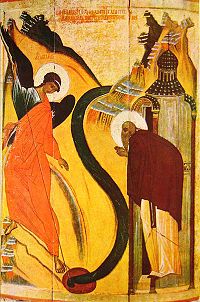- Colossae
-
Colossae or Colosse (also known as Chonae or Kona; Greek: Κολοσσαί, Χωναί/Χῶναι), was an ancient city of Phrygia, on the Lycus, which is a tributary of the Maeander River. It was situated about 12 miles South East of Laodicea, and near the great road from Ephesus to the Euphrates. The site, located near the modern town of Honaz in Turkey, has never been excavated.
Contents
History
In 396 B.C., during the Persian Wars, the satrap Tissaphernes was lured to Colossae and slain by an agent of the party of Cyrus the Younger. Pliny tells that the wool of Colossae gave its name (colossinus) to the colour of the cyclamen flower. During the Hellenistic period, the town was of some mercantile importance, although by the first century it had dwindled greatly in size and significance.
It does not appear that St. Paul had visited this city when he wrote his Epistle to the Colossians there (Col. 1:2, Col. 2:1), since he tells Philemon of his hope to visit it upon being freed from prison (see Philemon 1:22). It seems that Epaphras was the founder of the Colossian church (see Col. 1:7; 4:12).
This town fell into decay (possibly due to an earthquake) and the Byzantine town of Chonæ occupied a site near its ruins. A look at the classical, Byzantine, and otherwise medieval literature mentioning the site reveals a name change for part or all of Colossae to Cona or Chonae. The town was the birthplace of the Byzantine Greek writers Nicetas and Michael Choniates.
Chonæ was made an archbishopric about 858-60, and in some later episcopal notices appears as a metropolis.[1]
Miracle of the Archangel Michael
In Byzantine and Russian art, the theme of the Miracle of the Archangel Michael at Chonae (Τὸ ἐν Χωναῖς/Χῶναις Θαῦμα τοῦ Ἀρχαγγέλου Μιχαήλ) is intimately linked with the site. Eastern Orthodox tradition tells that the pagans directed the stream of a river against the sanctuary of St. Michael there to destroy it, but Michael the Archangel appeared and split the rock by lightning to give a new bed to the stream, diverting the flow away from the church and sanctifying forever the waters which came from the gorge. The Orthodox celebrate a feast in commemoration of this event on 6 September. The Monastery of the Miracle (Chudov Monastery) in the Moscow Kremlin, where the Russian Tsars were baptized, was dedicated to the Feast of the Miracle at Kona.
The 5th-7th century texts that refer to the miracle at Chonae formed the basis of specific paradigms for "properly approaching" angelic intermediaries for more effective prayers within the Christian culture.[2]
Notes
- ^ Catholic encyclopedia: Colossæ
- ^ Subtle bodies: representing angels in Byzantium by Glenn Peers 2001 Univ of Calif Press ISBN 0520224051 page 144 [1]
References
- Easton's Bible Dictionary, 1897.
- Bennett, Andrew Lloyd. "Archaeology From Art: Investigating Colossae and the Miracle of the Archangel Michael at Kona." Near East Archaeological Society Bulletin 50 (2005):15-26.
External links
- Map and pictures of ruins
- Commemoration of the Miracle of the Archangel Michael at Colossae Eastern Orthodox icon and synaxarion
- Commemoration of the Miracles of the Holy Archangel Michael Entry for September 6 in the Prologue from Ochrid by St. Nikolai Velimirovich
Coordinates: 37°45′26″N 29°15′59″E / 37.75722°N 29.26639°E
Categories:- Roman towns and cities in Turkey
- Pauline churches
- New Testament cities
- Former populated places in Turkey
- Phrygia
Wikimedia Foundation. 2010.

